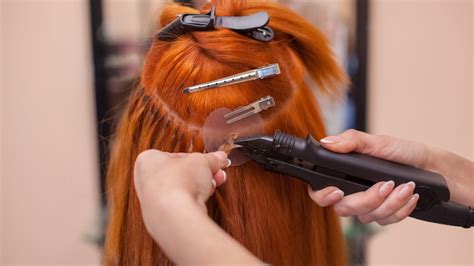Are you struggling with thin, limp hair that lacks volume and thickness? Hair extensions can be a transformative solution, offering you the instant fullness and body you crave. In this comprehensive guide, we’ll explore the 7 best hair extensions for thin hair, empowering you to find the perfect match for your desired look.

1. Clip-In Extensions
- Pros: Convenient, affordable, easy to apply and remove
- Cons: May be visible if applied incorrectly, can slip out of place
Clip-in extensions are the most user-friendly option for thin hair. They come in a variety of lengths and colors, allowing you to customize your look. Simply clip them into your natural hair at the roots to create instant volume.
2. Tape-In Extensions
- Pros: Natural-looking, long-lasting, reusable
- Cons: Requires professional installation, can be expensive
Tape-in extensions are thin, double-sided tape extensions that are applied to your natural hair. They blend seamlessly, creating a natural look that can last for up to 8 weeks. However, they require a professional stylist for installation and removal.
3. Halo Extensions
- Pros: Quick and easy to apply, comfortable to wear
- Cons: Not as customizable as other extensions, may not blend perfectly with natural hair
Halo extensions are a circular band of hair extensions that is placed around your head like a headband. They are a great option for those who want instant volume without the commitment of permanent extensions.
4. Ponytail Extensions
- Pros: Versatile, easy to style, can be used to create multiple looks
- Cons: May not be suitable for short hair, can be difficult to blend with natural hair
Ponytail extensions are a great way to add length and volume to your ponytail. They come in a variety of colors and lengths, allowing you to achieve a variety of different styles.
5. Micro Bead Extensions
- Pros: Lasts for several months, natural-looking, seamless blend
- Cons: Requires professional installation and maintenance, can be expensive
Micro bead extensions are small, keratin-coated beads that are attached to your natural hair using a special tool. They create a seamless, natural-looking bond that can last for up to 6 months.
6. Sew-In Extensions
- Pros: Long-lasting, versatile, can be customized to suit your hair type
- Cons: Requires professional installation and maintenance, can damage natural hair
Sew-in extensions are applied to your natural hair using a needle and thread. They are a versatile option that can be customized to match your desired length, color, and texture. However, they require regular maintenance and can be damaging to your natural hair.
7. Fusion Extensions
- Pros: Long-lasting, durable, versatile
- Cons: Requires professional installation and maintenance, can be expensive, can damage natural hair
Fusion extensions are applied to your natural hair using heat, which bonds the extensions to your own hair. They are a strong, durable option that can last for up to 6 months. However, they require professional installation and removal, and can be damaging to your natural hair.
When choosing hair extensions for thin hair, there are several factors to consider:
- Hair texture: Match the texture of your extensions to your natural hair to ensure a seamless blend.
- Hair color: Choose extensions that match your natural hair color or opt for a slightly lighter shade to create a natural highlight effect.
- Hair length: Consider the length of your natural hair and the desired length of your extensions.
- Installation method: Choose an installation method that suits your needs and preferences, considering cost, convenience, and longevity.
- Hair care: Research the different types of hair extensions and choose those that are compatible with your lifestyle and hair care routine.
Hair extensions offer a wide range of benefits for those with thin hair, including:
- Increased volume and thickness: Extensions instantly add body and fullness to thin hair, creating the illusion of thicker, healthier locks.
- Boosted confidence: Fuller, more voluminous hair can boost your confidence and make you feel more attractive.
- Variety of styles: Extensions allow you to experiment with different lengths, colors, and textures, giving you the versatility to create a variety of styles.
- Damage protection: Extensions can protect your natural hair from heat styling and environmental damage, allowing it to grow longer and healthier.
Hair extensions are a versatile and effective solution for those with thin hair. By choosing the right type of extensions and ensuring proper installation and care, you can achieve a fuller, more voluminous look that boosts your confidence and enhances your overall appearance. Embrace the transformative power of hair extensions and unlock your hair’s true potential.
Q: How long do hair extensions last?
A: The lifespan of hair extensions depends on the type of extension, the installation method, and the care you provide. Clip-in extensions can last for several months, while professional extensions like fusion and micro bead extensions can last for several months.
Q: Can hair extensions damage my natural hair?
A: Some types of hair extensions, such as sew-in and fusion extensions, can damage your natural hair if not installed properly or removed too aggressively. Choose a reputable salon and experienced stylist for professional installation and maintenance to minimize risk.
Q: How much do hair extensions cost?
A: The cost of hair extensions varies depending on the type of extension, the length, and the installation method. Clip-in extensions are generally more affordable, while professional extensions like tape-in and micro bead extensions can be more expensive.
Q: Can I style hair extensions with heat?
A: Most types of hair extensions can be styled with heat, but always follow the specific manufacturer’s instructions. Clip-in extensions can be heat-styled, while professional extensions may require special tools or techniques to prevent damage.
Q: How often should I wash hair extensions?
A: The frequency with which you wash hair extensions depends on the type of extension and your own hair care routine. Clip-in extensions can be washed more frequently, while professional extensions should be washed less often to maintain their integrity.
